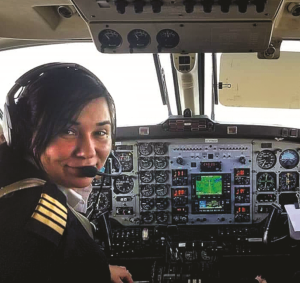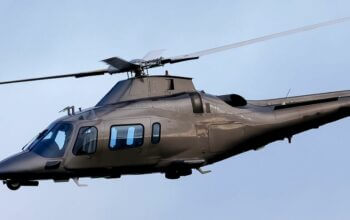Estimated reading time 7 minutes, 19 seconds.
“If you can’t find a role model, just become one.”
As an Indigenous female pilot, Robyn Shlachetka has been inspired by those words of encouragement more times than she can count.

They came from her dad, a float pilot who worked for Cross Lake Air in their hometown of Wabowden, Man., a small community of about 500 people located 600 kilometres north of Winnipeg.
Growing up, Shlachetka hung out on the floatplane dock, fuelling her dad’s plane and pumping water from the floats after sightseeing flights and fishing charters.
She traces her interest in aviation back to the summer of 1989, when wildfires ravaged the province. More than a thousand separate fires devoured 3.28 million hectares of land, forcing the evacuation of 24,500 people from central and northern Manitoba.
Wabowden was evacuated. Four-year-old Shlachetka and her family flew to safety in a DHC-2 Beaver with her dad’s boss, George Dram. Along the way, he let the young girl put her hands on the controls.
“That was my first and only attempt to barrel roll a Beaver,” joked Shlachetka during a recent presentation at the Regina Flying Club in Regina, Sask. “That rush of flying, the thrill and the excitement, was something that never left me. Neither did my sister’s fear of letting me fly!”
Today, at 33, Shlachetka lives in Thompson, Man. She’s a busy mother with four kids, two Great Danes and a cat in the house, and a rewarding career as a Beech 200 medevac captain with Missinippi Airways.
About a year ago, she and first officer Raven Beardy, another female Indigenous pilot, were catapulted into the public eye after Shlachetka’s mother posted a photo of the two of them in the cockpit on her Facebook page. The photo went viral, reaching people across Canada, the United States and even Australia. The pair was heralded as Manitoba’s first female Indigenous medevac crew.
“At this point, I had been well over a decade into my career and had never personally met another female Indigenous aviator,” said Shlachetka, who added that Beardy had filled in on that flight for her regularly scheduled first officer.
But while she may now be more well-known, there is no doubt that getting her career off the ground has been a tough slog.
With her family’s help and support, Shlachetka finished her commercial pilot licence and multi IFR rating in 2005 at Harv’s Air in Steinbach, Man., before moving to Thompson to work for Skyward Aviation. But the company closed its doors before she could start, and she had to take a job as a waitress. One day, a medevac crew came in from Perimeter Aviation, and after talking with them she applied and landed a check-in and reservations job at the company.
“Then I went on maternity leave with my first daughter at age 21, took minimal time off, and returned to work for another year on the ground.”
She got into the right seat of a Beech 99 and after two years it looked like it was time for her captain’s upgrade. But then two things happened: Perimeter made plans to decommission its Beech 99s and Shlachetka lost her medical when she was diagnosed with supraventricular tachycardia, a heart arrhythmia characterized by bursts of an abnormally fast heartbeat.
“After six months off work and fighting to see a specialist, I spent three hours getting a cardiac ablation done to get my medical back,” she said. “I was so excited to get back in the air, as my hours were high and my seniority number was climbing.”
But getting a captain upgrade on the Fairchild Swearingen Metroliner was not in the cards. Shlachetka said she was discouraged from pursuing it because having a family would prove “too distracting to fly a Metro.”
It was a bitter disappointment. But as that door closed, another opened.
Creeway Aviation, a small charter company in Thompson, was looking for a pilot to fly a Piper PA-31 Navajo. The job was a perfect fit.
“It was a much more stress-free environment. It was a lifestyle job, Monday to Friday. After I had enough time, I become chief pilot.”
It had taken almost six years from the time she earned her commercial licence for Shlachetka to finally captain an aircraft. She moved on to fly a Beech 100 at Wings Over Kississing before a medevac position came up at Missinippi Airways, northern Manitoba’s only wholly First Nations-owned airline.
“I hadn’t done that type of flying before,” she said, before adding that it is rewarding work. “You’re there for a reason. You’re not hauling freight. The charters I used to do weren’t bad work, but there is something to be said about helping people in the community. Nobody likes being woken up [for a flight] at 2 a.m., but you know it’s because someone really needs your help.”
With more than 6,000 hours in her logbook, Shlachetka has no desire to fly for a major airline.
“I never had dreams of flying overseas. I want to have a comfortable job at a base where I’m able to be home as much as possible and make enough money to support my family,” she explained. “Those were my goals in the beginning and they are still my goals.”
By flying in the north, Shlachetka feels she has a chance to make more of an impact on Indigenous communities, too. People talk to her when she’s at airports; she’s even inspired one mother to go back to finish off her high school diploma.
“People from our communities tend to get really excited about it. It’s rare. But I hope that eventually it will be mainstream to see me walking around at an airport. And when girls are growing up and thinking about what they want to be, maybe it won’t seem so far-fetched anymore.”
Becoming a role model for female Indigenous aviators hasn’t been easy. Shlachetka remembers the 5 a.m. mornings as a dispatcher, when she was bundling her 10-month-old daughter up to go to a daycare she could barely afford.
“I’ve learned it can be very difficult to do things first,” she concluded. “Everyone behind you is looking at you.
“But another thing I’ve learned is that there is more than one way to do it. You know the goal is there and you just keep going.”








